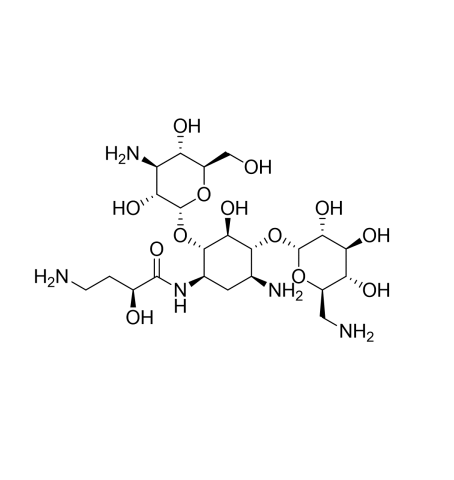Amikacin is a powerful, broad-spectrum aminoglycoside antibiotic developed in the 1970s to combat resistance to earlier antibiotics such as kanamycin and gentamicin. It was first synthesized in 1972 by researchers at the Japanese pharmaceutical company Sankyo as a semi-synthetic derivative of kanamycin A, with the goal of creating a more effective and resilient treatment option. Commercially introduced in 1976, amikacin has since become a key therapy for treating severe bacterial infections, particularly those caused by drug-resistant strains. It is administered by intravenous (IV) or intramuscular (IM) injection and is typically reserved for serious or life-threatening infections, most often in hospital settings under close medical supervision.
BRAND NAMES
Amikacin is marketed under various brand names globally, with Amikin being one of the most widely recognized. The specific brand names can differ by country and are manufactured by a range of pharmaceutical companies.
Amikin is a brand name for the generic antibiotic amikacin, commonly used to treat severe bacterial infections, especially those that do not respond to other antibiotics.
Amicin is a brand name for the generic antibiotic medication amikacin sulfate, which belongs to the class of aminoglycoside antibiotics.
MECHANISM OF ACTION
Amikacin works through the same primary mechanism as other aminoglycosides. It binds to the 30S subunit of bacterial ribosomes, disrupting the interaction between mRNA and tRNA at the acceptor site. This interference hampers bacterial protein synthesis, resulting in the creation of faulty or toxic proteins and ultimately inhibiting bacterial growth. While additional mechanisms have been suggested for this drug class, the main effect remains the inhibition of protein production. Amikacin, like other aminoglycosides, is typically bactericidal against both gram-positive and gram-negative bacteria.
PHARMACOKINETICS:
Absorption
Amikacin is quickly absorbed following intramuscular injection, as well as from the peritoneal and pleural cavities. However, it has poor absorption when administered orally or topically. Absorption is also limited when used in bladder irrigations or given intrathecally.
Distribution
Amikacin is an aminoglycoside antibiotic that distributes mainly in the extracellular fluid and has limited penetration into tissues. Due to its poor oral absorption, it must be administered through intravenous (IV), intramuscular (IM), or inhalation routes to effectively treat bacterial infections.
Metabolism
Amikacin is not significantly metabolized in the body and is excreted almost entirely unchanged by the kidneys via glomerular filtration. As a result, its elimination is closely linked to the patient’s renal function.
Excretion
Amikacin is eliminated almost exclusively by the kidneys through glomerular filtration, without undergoing any metabolic transformation in the body. It is excreted in its unchanged form, and the rate of elimination is directly dependent on renal function. In individuals with normal kidney function, approximately 95–98% of a single dose is cleared from the body within 24 hours.
PHARMACODYNAMICS
Amikacin is a bactericidal aminoglycoside antibiotic that exerts its effect mainly by blocking bacterial protein synthesis. Its pharmacodynamic characteristics, including concentration-dependent killing and a pronounced post-antibiotic effect (PAE), play a crucial role in determining its effectiveness and dosing regimen.
ADMINISTRATION
Routes: Amikacin is typically administered via intravenous (IV) or intramuscular (IM) injection.
Dosage: The dose and frequency depend on the severity of the infection, patient’s renal function, and body weight.
Monitoring: Regular monitoring of kidney function and drug levels is important to avoid toxicity.
Inhalation: In some cases, amikacin can be given by inhalation, especially for lung infections such as those in cystic fibrosis patients.
Oral use: Not effective orally due to poor absorption and therefore not used via this route.
Administration precautions: Proper injection technique should be followed to minimize pain and local reactions at the injection site.
DOSAGE AND STRENGTH
Amikacin dosing is generally calculated according to body weight. Once-daily administration may be preferred due to its potential advantages in both effectiveness and reduced toxicity. Dosage modifications are often required depending on the patient’s age, renal function, and the type of infection being addressed.
Amikacin injection is typically supplied as:
100 mg / 2 mL vial: Contains 50 mg of amikacin per mL.
500 mg / 2 mL vial: Contains 250 mg of amikacin per mL.
1 g / 4 mL vial: Contains 250 mg of amikacin per mL.
DRUG INTERACTIONS
Amikacin has significant drug interactions, especially with medications that may cause kidney damage (nephrotoxicity), hearing loss (ototoxicity), or impair muscle function (neurotoxicity). Using these drugs together can greatly elevate the risk of serious adverse effects.
FOOD INTERACTIONS
Amikacin, usually given by injection, has no known direct interactions with food. The primary dietary focus during treatment is to maintain overall health and help reduce possible side effects.
CONTRAINDICATIONS
The key contraindications for using amikacin include hypersensitivity to the medication, pregnancy, and simultaneous use of other drugs that may amplify its toxic effects. As a powerful aminoglycoside antibiotic, amikacin carries significant risks of serious and potentially irreversible toxicities, especially affecting the kidneys and inner ear.
SIDE EFFECTS
Nausea and vomiting
Headaches
Fever
Pain, redness, or swelling where the injection was given
Fatigue or weakness
OVER DOSE
Amikacin overdose is a medical emergency that can cause serious and potentially permanent damage to the kidneys, ears, and nervous system. If an overdose is suspected, immediately seek emergency medical attention by calling emergency services or a Poison Control center.
TOXICITY
Amikacin, a powerful aminoglycoside antibiotic, has significant toxic effects primarily on the kidneys (nephrotoxicity), the ears (ototoxicity), and the nervous system (neurotoxicity). Due to its narrow therapeutic index, meaning the dose that is effective is close to the dose that is toxic, amikacin is typically reserved for severe bacterial infections and requires careful monitoring.



